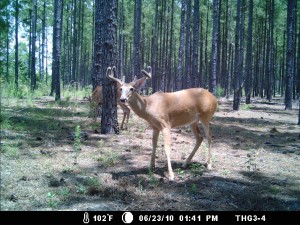
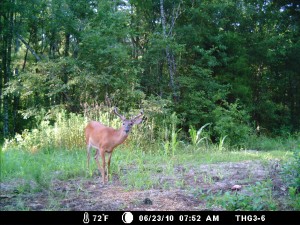
So by now you are asking, how do you fish for whitetail bucks? Obviously you do not do it with a fishing rod. It is a term that I use to describe a technique to locate and pattern big bucks using trail cameras. I have been developing this technique for the last 3 years and I thought I would share it with you.
The first thing I do, whether it is hunting a new area or an area that I have hunted before, is to study aerial maps to determine the possible core area of these bucks. I look for areas where there will be food for the spring and summer and the areas that provide them the best cover and protection. I have discovered that bucks have summer core areas that they have been using for years. When you see young bucks traveling with older bucks during this time, you can bet that the young bucks will take over these core areas as they get older.
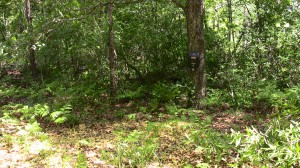
The next thing I do is I gather past data if I have some to determine my initial locations. If it is a location that I got good buck photos the year before, then I will automatically begin with a camera setup at that location. Then I will start compiling past information together while studying the aerial maps again and trying to think like a whitetail buck. This is why I call it fishing. You theoretically “throw the cameras” out there in locations that look promising then start adjusting as time goes by.
Once I have all my locations on paper, I will get some type of attractant to put in front of these cameras. I will use corn, soybeans, mineral blocks, etc… to try to get the bucks in front of the cameras so it will take their picture.
I normally try to put out enough attractant to last 2 to 3 weeks. Once this time is up, I will go and collect all the memory cards and study the photos. I will not put additional attractant out or remove a camera until I have looked at the photos and determined the effectiveness of that location. One thing I have noticed over the years is that some locations are better early and some are better later. Why is this? It is due to what the bucks are eating. They could be eating fresh growth such as honey suckles, plums, and/or blackberries early in the season and then switch to agriculture crop fields later when they become mature and more edible. Once again, try to think like a whitetail buck.
Once I have revamped my strategy, I will then go back and put out my attractant and move the other cameras to new locations. This is the recasting part of the fishing analogy. I will normally start this process after May 15th and I will continue until September 1st. September 11th is opening day for archery in Georgia and that is the reason I stop September 1st.
From this process, I will determine travel patterns of these bucks and will start developing bow stand locations to intercept them during the daylight hours. One more thing to note is that I try to move cameras along trails to see if I can get more than one series of photos of a particular buck. If you can map his travel and what time of day/night he is traveling this can be some key intelligence in harvesting him. I have a future case study of a buck that I was successful in mapping his travel route.
Now all this work is great for the preseason and understanding their summer pattern. These bucks will stay on this pattern in their bachelor groups but they will tend to start to roam further as they rub their velvet off and the testosterone starts to increase in their body. It still gives you a great starting point to know where the bucks are in the area and what they are doing.
Now I have been talking about bucks BUT as you gather and compile all your photos, make notes as to what does are in those areas. I try to identify the does that have twins which I would consider “breeder” does. I also try to indentify the does that have their fawns first. These are the does that come into estrus first and therefore are bred first. I believe these mature bucks know who these does are from past years. These does normally have a 200 to 300 acre core area and when the pre-rut and initial early rut phases start, you want to be hunting them, due to this fact. Mature bucks will be roaming this area looking for the first does in season and you will be sitting there waiting.
Shown below are a few pictures of my trail cameras and attractant setups. I like to set my cameras pointing either North or South so that the rising or setting sun does not set off the camera sensor. I also like to trim all the brush, grass, or small trees around my location. I will use a brush axe or I like to use a weed eater to trim the grass back. I learned this lesson of not trimming one time and I got over a 1000 pictures of a bush going back and forth in the wind.
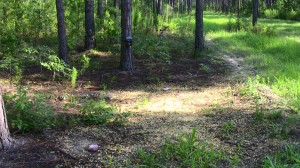
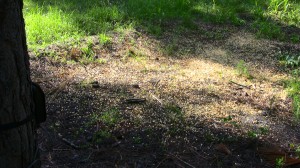
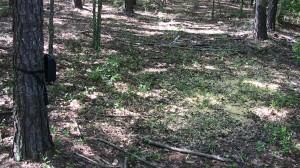
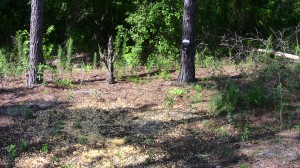
Now I also filmed some video of me setting up a fishing spot with some other locations that I am currently using. I also included some deer photos to these locations to show you what I have caught. Watch the video and you might see something that might help you while setting up your spots.
I mentioned a case study earlier in this article and once I have gathered all of the photos for the summer, I will post an article about the success of this year’s fishing. This data always helps me revise my technique and allow me time to reevaluate my success and failures. In the meantime, here are some photos of the deer I have caught while fishing this year. Stay tuned for more photos as I re-bait my hooks and start to cast again.
[…] This post was mentioned on Twitter by Thomas Allen and Thomas Allen, Toxie Givens. Toxie Givens said: Fishing for Whitetail Bucks: Read my article and watch video at http://www.toxiegivens.com/?p=377 #hunting #trailcameras #whitetail #deer […]